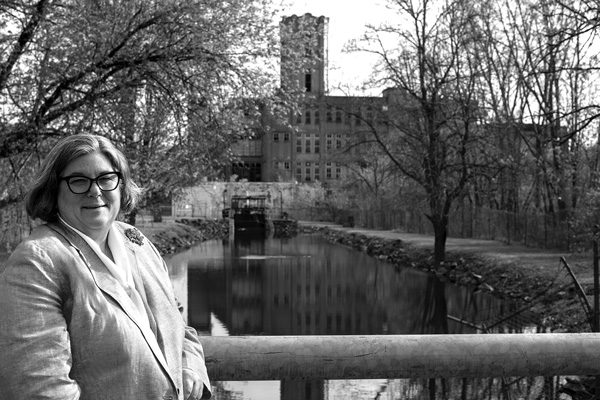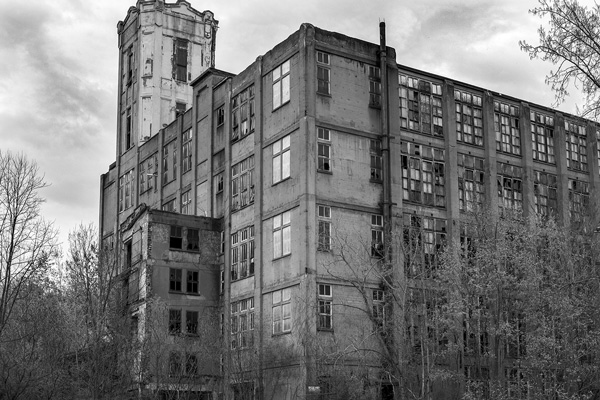News & Issues May 2023
Seeking new life for ‘white elephants’
Assemblywoman pushes bigger tax credit to redevelop historic structures

Assemblywoman Carrie Woerner stands outside a long-vacant mill complex in the village of Victory, N.Y. It’s the kind of structure she says could be redeveloped to ease the state’s housing shortage -- with help from an expanded tax credit for large historic buildings.Joan K. Lentini photo
By MAURY THOMPSON
Contributing writer
VICTORY, N.Y.
A historic, five-story mill building in the Saratoga County village of Victory has been vacant for nearly a quarter of a century since Victory Specialty Packaging Co. closed it operation there in February 2000, laying off 75 employees.
“We’ve been trying to find an angle forever” for how to redevelop the sprawling old mill, Victory Mayor Patrick Dewey said.
A few years after the plant closed, Saratoga County foreclosed on the property for unpaid taxes. In 2008, the county sold the property to Long Island developer Uri Kaufman, who said he hoped to transform it into an apartment complex.
But that project never advanced, and in 2018, Kaufman made a deal to sell the property to developer Larry Regan, who so far has been unable to put together the financing to redevelop it.
The 350,000-square-foot factory complex, originally used as a cotton mill, employed as many as 200 in the latter half of the 20th century.
Assemblywoman Carrie Woerner, D-Round Lake, says cavernous abandoned factories such as the one in Victory could find new uses to address the state’s housing crunch — with a little financial jump-start from the state.
The Victory mill is one of 35 properties across the state that meet the criteria for size, longevity and long-term vacancy that would allow them to obtain assistance under a proposed “white elephant” historic tax credit that Woerner is championing, according to the state Office of Parks, Recreation and Historic Preservation.
Other structures that could qualify for the tax credit include the former Mount McGregor Correctional Facility complex in the towns of Moreau and Wilton, the former Hudson River State Hospital campus in Dutchess County, and the dilapidated Central Warehouse in Albany. The long-vacant former Doane Stuart School in Albany, which was destroyed by fire in late March, also would have qualified.
Woerner’s proposed legislation aims to help spur revitalization of buildings that are “too expensive to demolish and too expensive to rehabilitate.”
These “old behemoths” too often fall into disrepair and can become safety hazards if left vacant for too long, she said.

The former Victory Specialty Packaging Co. mill has been vacant since that company ceased operation in 2000. A series of developers have proposed turning the complex into apartments but have been unable to attract enough support from investors. Joan K. Lentini photo
Big projects, bigger credit
Woerner introduced legislation in January that would extend the state’s current Historic Rehabilitation Tax Credit program through the end of 2034 and add a new category for “white elephant” structures. These buildings already qualify for state historic tax credits but would become eligible for a larger credit under Woerner’s legislation.
Woerner’s proposed legislation was incorporated into a one-house budget bill that passed the Assembly.
As of late April, however, the “white elephant” tax credit proposal had not gained support from the state Senate or Gov. Kathy Hochul, although negotiations were still under way for a state budget for the fiscal year that began April 1.
Woerner said there is still an outside chance the legislation could be incorporated in the final state budget.
“Hope springs eternal,” she said.
If not, she said she would continue to champion the proposal next year, when there may be a greater sense of urgency, as the current historic tax credit program expires at the end of 2024.
State Sen. Timothy Kennedy, D-Buffalo, has introduced Senate companion legislation, which had two co-sponsors as of April 21.
The New York Association for Affordable Housing has endorsed the legislation and promoted it at the association’s annual lobbying day, said Judy Calogero, a consultant and former state housing commissioner in Gov. George Pataki’s administration.
Calogero, who is chairwoman of the Glens Falls Industrial Development Agency, said she encouraged Glens Falls Mayor Bill Collins to suggest that the New York Council of Mayors endorse the legislation.
Historic tax credits are a mechanism to raise investment for projects that might otherwise be impractical. The developer uses the tax credits to raise investment.
In essence, the state is providing future tax relief in exchange for investors providing immediate cash to fund a qualifying project. The developer receives a dollar-for-dollar tax credit, which can be redeemed in the future. The credit can be transferred to an investor.
A tax credit is different from a tax deduction, which reduces the amount of income that is subject to taxation. A credit, in contrast, reduces the amount of taxes owed.
Under Woerner’s legislation, projects could receive up to $15 million in tax credits, allocated over a five-year period, based on a percentage of certain redevelopment costs. That essentially means a developer or investor could recoup up to $15 million of their investment through future savings on their state taxes.
To be eligible, renovation of the structure must be “substantial.” The building must have been vacant for at least 10 of the previous 15 years.
The state tax credit would dovetail with a federal historic tax credit program that provides savings on federal taxes.
Woerner said the new tax credit would have no immediate fiscal impact on the state, because the credits could not be redeemed until five years after a project is completed.
“It’s not the first year, it’s not the second year, it’s not the third or the fourth or the fifth years,” she said.
In theory, the economic benefit of the construction and related development would offset the cost of the future reduction in tax receipts, Woerner added.
Growing while conserving resources
Renovating historic buildings, rather than building new ones, helps conserve open space in addition to stimulating the economy, said Sean Kelleher, the town of Saratoga historian.
“Preserving historic structures like the Victory Mill not only maintains the character and charm of the surrounding community, but also promotes sustainable development practices,” he said. “The rehabilitation process can create jobs and stimulate economic growth in the area, while also reducing the need for new construction and conserving natural resources.”
Woerner was involved in local historic preservation efforts for many years before she first won election to the Assembly in 2014, including through a six-year stint as executive director of the Saratoga Springs Preservation Foundation. She said she came up with the idea for a “white elephant” tax credit when she was brainstorming ideas with Dewey, the Victory mayor, about the stalled effort to repurpose the old mill in the village.
Regan, the developer who now controls the property, announced a $60 million plan in 2019 to redevelop the mill, creating 186 apartments and a microbrewery. The town Planning Board approved the project, and the Saratoga County Industrial Development Agency approved a tax abatement plan.
But so far Regan has been unable to line up sufficient backing from investors.
“He’s tried many different angles to get that redeveloped,” Dewey said.
Woerner’s proposed tax credit could finally be the ticket to redevelopment, said Kelleher, the town historian.
“It’s unfortunate that such a promising proposal has stalled, especially given the support it had from the county,” Kelleher said. “Overall, the ‘white elephant’ historic tax credit program is a promising proposal that could help breathe new life into historic structures like the Victory Mill.”
The mill was listed on the National Register of Historic Places in 2009 because of its historical significance as a textile mill and as an example of early 20th century industrial architecture, Kelleher said.
Mount McGregor’s white elephant
High cost also has been a hindrance to redeveloping the former Mount McGregor Correctional Facility, Moreau town Supervisor Todd Kusnierz has said.
The former prison occupies the mountaintop location of the former Balmoral Hotel, a resort that was destroyed by fire in 1897. The current buildings, dating back to 1913, were used as a tuberculosis sanitarium, a veterans’ rest camp, a center for the developmentally disabled and, beginning in 1984, as a medium security correctional facility. The campus has been unused since the prison shut down in 2014.
Possible new uses discussed for the site have included a mixed-use residential, retail and service business complex, a law enforcement training center and a conference center, Kusnierz has said.
The most recent redevelopment proposal, in early 2022, was to reuse the site for a paranormal education center, cultural heritage museum and for architectural history tours, car shows and weddings. That plan hit a snag when interest rates went up, local officials have said.
A new wrinkle surfaced when the state Redevelopment Commission report in December revealed that a constitutional amendment would be required in order to transfer the entire 325-acre property to a single private developer.
Local officials previously thought that an amendment would not be needed because the site is outside the boundaries of the Adirondack Park. But the Redevelopment Commission report explained that state-owned property adjacent to the Adirondack Park can only be transferred to private owners in parcels of 100 acres or less unless voters approve a state constitutional amendment allowing specific larger transfers. Passing a constitutional amendment involves a process that takes a minimum of two to three years to complete.
The only way to redevelop the property without a constitutional amendment would be to subdivide the property and transfer a parcel of 100 acres or less.
